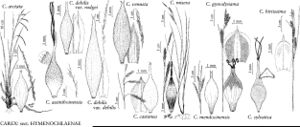Carex debilis var. debilis
Lateral spikes pistillate, perigynia overlapping, attached 3–6 mm apart. Pistillate scales with hyaline margins white or pale, apex usually blunt to acute, rarely cuspidate. Perigynia fusiform, 5.5–8.7 mm, apex tapering gradually to elongate beak, nearly 1/2 length of perigynium. 2n = 52, 54, 55, 56.
Phenology: Fruiting early–mid summer.
Habitat: Edges, openings, paths and stream banks in mesic deciduous forest, floodplain forests, meadows, wet prairies, and roadsides, usually on soils with pH below 6
Elevation: less tham 500 m
Distribution

Ala., Ark., Conn., Del., D.C., Fla., Ga., Ill., Ind., Ky., La., Md., Mass., Mich., Miss., Mo., N.J., N.Y., N.C., Ohio, Okla., Pa., S.C., Tenn., Tex., Va., W.Va.
Discussion
Most specimens of Carex debilis var. debilis have glabrous perigynia, but those with pubescent perigynia occur sporadically through the eastern part of its range, usually in mixed populations with the glabrous form. This southern variety extends north along the coastal plain to Nantucket Island, Massachusetts and occurs sporadically in Michigan and Ohio along with other coastal plain disjuncts. Occasional sterile hybrids with C. venusta have been confirmed in Florida, North Carolina, and New Jersey and observed in South Carolina and Virginia.
Selected References
None.
Lower Taxa
"shortened" is not a number."thick" is not a number.
